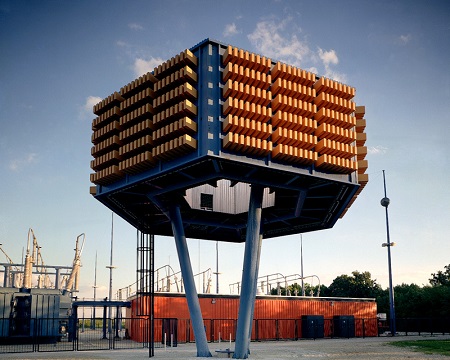"CapTree" to Bloom Anew

The capacitor tree, 1977.
Fermilab' s 6800-acre site is rich in history and character, both natural and man-made. Representing the latter part of that history and character is the now functionally defunct Capacitor Tree (CapTree). In conjunction with Fermilab's celebration of Arbor Day, the CapTree will be "refoliated" with the last of 860 orange fiberglass boxes that simulate the CapTree's original capacitors.
An unusual species among the man-made flora in the area, the multi-trunked, six-sided structure "grows" at the intersection of Roads A and B near Fermilab's power station. "Originally, the CapTree was a power storage device, but it hasn't been used for at least 7 years," explained David Warner (Accel. Div./Mech. Suppt.).
There were a couple of ideas on what to do with the CapTree. One of them was to "chop" it down, but that would serve no purpose. "It's a landmark; everybody knows where it is," said Jack Lockwood (Accel. Div./EE Suppt.). Fermilab Director Emeritus Robert R. Wilson, who originally conceptualized the CapTree, wanted to retain it as an "aesthetic artifact; a part of Fermilab's evolution."
Returning the CapTree to its original condition required more than a simple root feeding. Lockwood commended Jim Hogan (Accel. Div./Mech. Suppt.), Warner's supervisor, for volunteering his Department for the challenging project. As project leader, Warner spent the last year coming up with ideas on how to refoliate the tree. "I worked with [Fermilab Artist] Angela Gonzales at the beginning of the project, and we went over a few preliminary ideas on what to do with the CapTree. We gave those ideas to Dr. Wilson, but he wanted the original capacitors on the tree because they were a part of his design."
Unfortunately, the original capacitors were contaminated and unusable, and new capacitors would be too expensive. Therefore, the best solution was to simulate the original capacitors. Explained Warner, "We considered several options. One inexpensive option was to use painted wood blocks, but those wouldn't weather very well." Eventually, Warner came up with the fiberglass box idea, which was the best option because fiberglass boxes would be relatively inexpensive, durable, and best resemble the original capacitors.
The fiberglass boxes are coated with orange polyurethane paint with UV inhibitors. "It's the kind of coating found on truck bodies and sailboats – it really weathers very well," Warner said. In addition to matching the color of the original capacitors, the new orange "foliage" gives the CapTree an almost perpetual autumnal appearance.
Mounting the fiberglass boxes on the CapTree was hard work. Without capacitors, the CapTree was covered with 860 holes, and the threads in the holes had corroded. To eliminate the corrosion, Jeff Meisner (Accel. Div./Mech. Suppt.) and Bob Slazyk (Accel. Div./Mech. Suppt.) had to squirt WD-40 into each of the holes. Then, to mount the sealed boxes, Warner, Slazyk, and Meisner borrowed a bucket truck from the "plant" maintenance people at Site 38. "I got up in the bucket truck and hung a number of the boxes just to get my hands dirty," said Warner, "but Meisner and Slazyk did the hard work."
Sounding like a horticulturist who had nurtured a hybrid rose, Warner said, "It has been an interesting project. At first, it was a real challenge, but in the end, it worked without a hitch."


